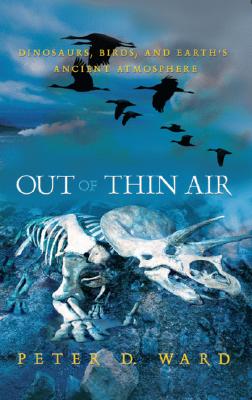

| OUT OF THIN AIR Dinosaurs, Birds, and Earth's Ancient Atmosphere Peter D. Ward David W. Ehlert (Illus.) Washington, DC: Joseph Henry Press, 2006 |
Rating: 5.0 High |
|||
| ISBN-13 978-0-309-10061-8 | ||||
| ISBN 0-309-10061-5 | 282p. | HC/BWI | $27.95 | |
There are many conundrums associated with the development of life on Earth. Peter Ward explores one in this book: Was the assortment of body plans we see in animals past and present affected by the changing composition of the atmosphere, and if so, how?
Enormously interesting and complicated questions can be asked: Why does a group of organisms diversify? Why do we observe particular body plans and morphologies and what functions do they serve? Why are there so few (or so many) of any particular taxonomic unit, such as the orders or families of reptiles, or of mammals, for instance? Indeed, why are there mammals or reptiles at all? Why not some other biological reality? Why not truly flying fish, or water-breathing mammals, or even fire-breathing dragons, for that matter? Why are there no dinosaurs, for instance? Now we can begin to see that the world of animals that now exists is just one of any number surely possible, at least theoretically. But for a particular battle in human history the map of nations would be radically different, and but for a particular disaster so too could the book of animals now on the planet be a radically different volume. – Page 6 |
Berner Curves, generated by computer models called GEOCARBSULF and COPSE, clearly show an inverse relationship (with some exceptions) between levels of O2 and CO2 in the atmosphere. The reasons are unclear, but may have to do with asteroid impacts like the one that formed Chicxulub Crater and destroyed the dinosaurs 65 million years ago.
That crater off the Yucatan Peninsula is well accepted. More speculative is the hypothesis that a structure named Bedout, near Australia, resulted from an impact that 251 million years ago caused the great spate of extinctions in the Triassiac. (See Ward, P. 139.) For one thing, this extinction appears to have been far more protracted, lasting a million years or so.
Whatever their cause, dips in the O2 level correlate fairly well with periods of extinction and subsequent spikes in diversity. Ward's thesis has supporting evidence.
It is a fascinating question — the more so because it flows from the crumbling of another bulwark of the conceit that conditions on today's Earth have persisted throughout its long history, or at least since the surface cooled, seas formed, and life arose to create the oxygen in the atmosphere. Today we enjoy a concentration of about 21% oxygen; but in past epochs this has dipped as low as 12% and peaked at perhaps 35% during the Permian period.1
The above series of questions perfectly captures the passion for inquiry that drives Peter Ward in his scientific work. That passion comes through clearly throughout the book, and makes it a fascinating read. Be warned: this is not a book for the casual reader. It sets forth an intricate chain of reasoning, with many side branches explored and abandoned as dead ends. But those interested in paleontology, amateur and professional alike, will find it a gripping account, well complemented by David Ehlert's illustrations. Extensive endnotes and a good index are provided. The text contains fewer of the errors in grammar, syntax, or continuity I've found in Ward's earlier work. With the provisos that its profusion of specialized terms can be hard going, and that it lacks a concise concluding section, I give it my highest recommendation.

 To contact Chris Winter, send email to this address.
To contact Chris Winter, send email to this address.